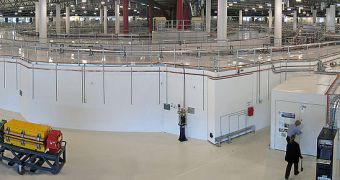For the first time ever, a scientific facility of the synchrotron-class is plagued with a clash of cultures. The researchers and scientists involved in the international project are in a row with members of the board and with lawyers. The differences stem from the different perspectives that the two groups have in mind for the facility. While the board wants more financial gains, the experts are focused on achieving results worthy of being published in high-impact scientific journals, Nature News reports.
The facility is the largest scientific experiment in Australia, but relations between scientists and the board have broken down completely in recent weeks. Researchers from around the world, who form the Australian Synchrotron's Science Advisory Committee (SAC), say that lawyer Catherine Walter needs to leave the initiative, or else they all will. “If the committee resigns, no eminent scientist from around the world is going to touch the Australian Synchrotron with a bargepole,” one SAC member says under the cover of anonymity.
“We have drawn a line in the sand. Of the 40-odd synchrotrons around the world, I don't think this has ever happened before,” University of Melbourne expert Frank Larkins, who is the chair of the committee, adds. He says that Walter is very much business-oriented, a purpose that the researchers care very little about. “The 'bottom-line' priorities for the scientists are matters such as publications in high-impact journals,” Larkins shares. On the other hand, the board wants financial returns on investors' money, and so the latter needs to “be balanced with the science priorities,” he adds.
“What Australia hasn't realized is that it is trying to get an international scientific project to work. It's not just a synchrotron issue. It's about trust, faith and the ability to manage big science facilities,” University of Heidelberg expert Michael Grunze, who is also an SAC member, says. The committee explains that Walter, who is part of the seven-member board of directors, routinely disregarded their recommendations for plans of securing up to Aus$250 million in funding, for after 2012.
“You need to build a consensus on what the money should be spent on and what science you need to do. We advised the board accordingly, but the chair took no significant action,” Larkins adds. “In the first year we never even got a reply recognizing that our recommendations had been received,” Grunze says. The situation escalated when the facility's Director Chemist, Robert Lamb, of the University of Melbourne, was fired without notice and explanation. The researchers immediately switched from working 24 hours a day to a 9-to-5 program.
“We were doing extremely well. We were running just below budget, had raised a considerable amount of money and were very popular with the national and international scientific user communities,” Lamb points out. The board refused to discuss the sacking, saying they needed to keep things under wraps. SAC has now resumed the protests and limited work hours, and says it will not deter until Walter is fired. Unless this happens, it will, and no scientists will ever touch the nine high-tech beamlines at the synchrotron.
“In our collective experience spanning decades and continents, no synchrotron director has ever been removed from office without notice,” they say.

 14 DAY TRIAL //
14 DAY TRIAL //